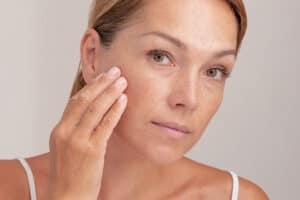
Dark or light patches of skin and visible blood vessels can mar your complexion. These spots are difficult to cover with makeup and don’t typically respond to topical treatments. Many people struggle with skin pigmentation changes, especially as they get older, but advanced technologies and cosmetic treatments offer hope.
Dr. Arie Benchetrit offers non-surgical treatment for skin discoloration with intense pulsed light (IPL) therapy in Montreal and Pointe Claire, Quebec. He is a certified plastic surgeon specializing in laser treatment and cosmetic surgery. A consultation with Dr. Benchetrit can determine the best method to improve your skin tone for a more even facial appearance.
Types of Skin Discoloration
Skin discoloration is any noticeable variance from your normal skin tone. These patches, spots or web-like formations may appear red, gray or blue. Birthmarks, skin conditions (rosacea) and excessive sun exposure may lead to skin discoloration. Hyperpigmentation, or dark patches, may be caused by ultraviolet (UV) light exposure, hormonal changes, rashes or a medical condition.
Sunspots go by many names, including age spots, liver spots or their more technical term, solar lentigines. These skin changes are common in adults over 50, but younger people may develop sunspots after spending a lot of time in the sun or commercial tanning beds. This skin discoloration occurs when UV light increases melanin production (the substance responsible for the skin’s natural pigment). Skin tissue that has spent years and years in the sun will develop sunspots in areas where melanin clumps together or accumulates in high concentrations.
Spider veins are another type of skin discoloration affected by sun exposure, weather changes, aging and other factors. These broken blood vessels appear as small, red lines in a web-like pattern and often develop on the face and legs. Rosacea is a skin condition that also affects the blood vessels in the face. Though the cause is largely unknown, people with rosacea experience flares when exposed to extreme temperatures, sun, wind and other triggers. The blushing or flushing caused by rosacea flares leads to visible blood vessels and pus-filled bumps.
IPL Therapy Can Improve Skin Discoloration
Intense pulsed light therapy is a non-surgical and non-invasive procedure that uses a broad spectrum of light to target, heat and destroy cells containing the unwanted pigment. Research shows that these treatments improve skin tone issues, including sunspots, rosacea and spider veins, but may require ongoing treatments to maintain a clearer complexion.
Dr. Benchetrit uses the Sciton BBL system for IPL treatment. A handpiece glides over the affected skin, emitting light at a specific wavelength to target the pigmented cells and blood vessels. The brown or red pigment absorbs the light from the IPL device, destroying the cells and restoring an even skin tone. IPL therapy may also reduce pore size and improve skin texture.
IPL treatments take about 20 minutes. Patients may have slightly red skin afterward, but no downtime is necessary. IPL results may last up to a year or longer before requiring maintenance sessions.
Learn More About Intense Pulsed Light Therapy for Skin Discoloration
Our certified plastic surgeon can determine if IPL therapy is the best way to improve your sunspots or skin discoloration with a consultation at our Montreal or Pointe Claire offices. Schedule an appointment with Dr. Benchetrit by calling (514) 613-4355.
















